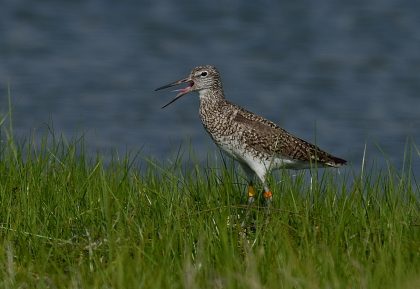
Believe it or not, southbound migration has already begun. Just a few weeks ago in early June, there were plenty of northbound migrant shorebirds and even a few songbirds still moving through the mid-Atlantic. After perhaps a week or two of migration slack tide, birds are beginning to ebb south again.
Willets are one of these early movers. While most shorebirds are fattening up on horseshoe crab eggs to head north, willets depart so early that the eggs are fueling their southbound migration.
We learned from our tracking research that New Jersey willets would begin departing in late June. On the 4th of July many of our willets would be over the Atlantic Ocean, on a direct flight to stopover and wintering sites in northern South America.
One of the most interesting things we have discovered is that this departure timing varies by latitude. I’ve been working with collaborators in New England (Biodiversity Research Institute and Biodiversity Works). Bringing our respective data together has revealed a fascinating latitudinal gradient in the timing of the willet’s life cycle.
We have a manuscript completed that describes a progressively later schedule at more northerly latitudes. New England birds do everything later than New Jersey birds.
Throughout their life cycle northern birds migrate north later, nest later and migrate south later than southern birds even though most east coast willets are traveling to common wintering sites in South America.
We make the case in our paper that the timing of salt marsh green up at nesting sites dictates the timing of nesting and all subsequent stages of the life cycle. We use climate and salt marsh biomass data to show this.
The data keep coming and are making the story increasingly convincing. Biodiversity Works in Martha’s Vineyard had a banner year, recovering five geolocators. The good news is that we have a nice sample of data from this site. The bad news is that I need to revise the paper to include these new data!
Particularly vindicating is that the team on the Vineyard captured a notorious bird that gave us the slip in previous years. One of our field days spent in a failed pursuit of this bird was amusingly documented in this article.
Using our own geolocator data along with previous banding data has given us clear view of eastern willet migration biology and has revealed key stopover and wintering sites. We’ve learned that it really is a small world for willets – those stopover and wintering sites comprise just a few places in Brazil and the Guianas.
The next frontier is the Gulf Coast. We know nothing about eastern willets that nest on the Gulf or the places they go during the nonbreeding season. But friends at the Gulf Coast Bird Observatory and U.S. Fish and Wildlife Service are now engaged in figuring it out. They deployed geolocators in 2015 and 2016 and recovered a tag this season. Where did it go? When did it go there? All will be revealed in a future post!